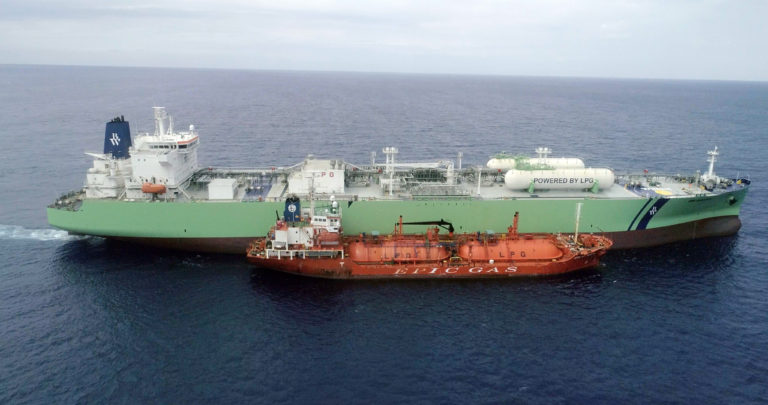BW LPG and BW Epic Kosan work alongside each other for mutual benefit.
A Case Study in Collaboration
Since the conversion of BW Gemini in November 2020, the world’s first Very Large Gas Carrier (VLGC) to be powered by LPG dual-fuel propulsion technology, seven more vessels have followed in its wake. The retrofitting process shone the spotlight on a core company value, collaboration. The LPG propulsion program not only required intense internal coordination at BW LPG, but also the support of BW Epic Kosan. Collaboration between the two companies realised another industry first – the ship-to-ship transfer of LPG as fuel.
The discharge of remaining LPG heel (a small quantity of LPG needed to keep cargo tanks at low temperatures), prior to drydocking and loading of LPG as fuel post-conversion, were conducted at terminals near the yard. However, the coordination with terminal schedules proved complicated and added delays to tight conversion timelines.
BW LPG reached out to BW Epic Kosan for a helping hand to solve this problem – realising a mutually beneficial arrangement. BW LPG chartered the 2008-built LPG carrier BW Epic St. Martin to facilitate the discharging of LPG heel gas and any remaining LPG cargo onboard the VLGC prior to drydocking, and the loading of LPG as fuel onto the newly installed LPG deck tanks via ship-to-ship transfers (STS).
Redelivered in May 2021, BW Balder was the first VLGC to receive LPG bunker via STS.
Ship-to-Ship (STS) Transfer Operation
During an STS operation, one vessel, typically the larger vessel, will keep its course, while the other vessel approaches slowly by course alternation. When they are close enough, the crew onboard will send heaving lines, messenger lines, and mooring lines across each vessel. When all mooring lines are tightened, the STS operation begins. This process was followed with BW Balder and BW Epic St. Martin, and all vessels after that, such as BW Var and BW Volans.

STS of Cargo, STS of Fuel
There is no difference during the STS of LPG as fuel instead of cargo. The focus remains on safety and following all established processes. Essentially, instead of filling cargo tanks, the deck tanks are filled with LPG as a bunker to propel BW Balder. A follow-up question will be if there is any difference between an STS operation conducted at sea (which was done for BW Balder) and one conducted at anchorage. The answer is yes and no – the process remains the same, but it is a bit more complex because these vessels can be bigger than a bunker barge, requiring skills and experience to maneuver.
Time Well Spent
Typically, traditional bunker fuels are taken in Yosu, Fujairah, and Panama. A full bunkering normally takes twelve hours. For LPG bunkering, the time required is similar, and there are many ports around the globe where LPG bunkering facilities and infrastructure are available. With LPG propulsion, we do not need to stop to take traditional bunkers, which saves us time and increases the commercial availability of our vessels.
There are two LPG deck tanks on the upper deck, and they are about 820 cubic meters each when fully refrigerated at -42 degrees Celsius. We can also top up our LPG cargo tanks if necessary. These numbers mean that with BW Epic St. Martin, which has a capacity of 5,000 cubic meters, we can perform quite a few STS bunker operations based on the quantity required. This arrangement has saved our site team time and money, and it reduced the complexity of our operations and schedules.
A Part of the Solution
The infrastructure for distribution and bunkering is already largely available to serve the potential marine market demand. More than 1,000 LPG storage facilities around the world can be used for LPG bunkering, and more than 700 small-size LPG carriers can be used for ship-to-ship (STS) bunkering. Climate change and decarbonisation issues are gaining momentum, both as a global necessity and as an economic opportunity. As the world considers the many pathways towards a zero-carbon future, LPG is a part of the solution. It can help the shipping industry meet decarbonisation goals while generating positive business outcomes. One other thing is clear from this example: the BW companies are there to support one another as they navigate a changing and complex world. Together, we find solutions for tomorrow.
Read More
– Read about LPG and its benefits at The World LPG Association.
– Read about the benefits of LPG as marine fuel.
– Read about our sustainability efforts here.
Topics: ship-to-ship transfer, emissions reduction, carbon reduction, Sustainability, environmental protection, technology, LPG propulsion, innovation, Very Large Gas Carrier, LPG shipping, Liquefied Petroleum Gas

